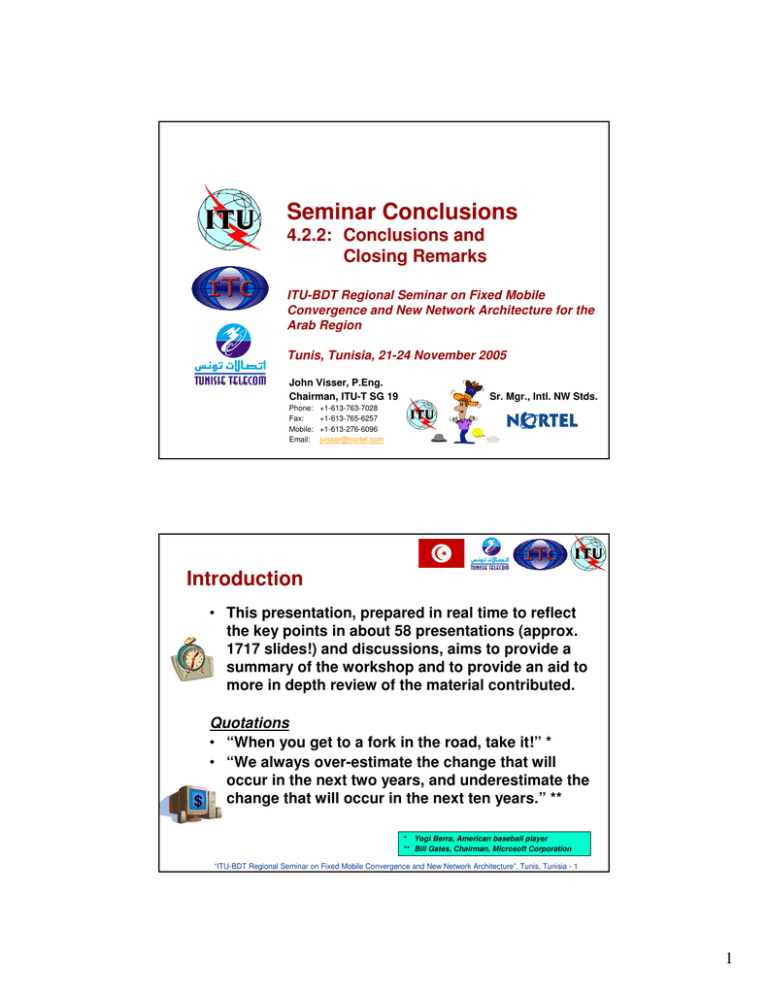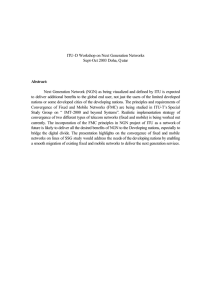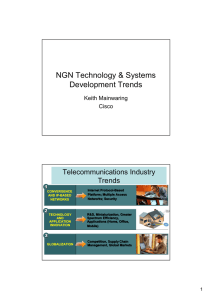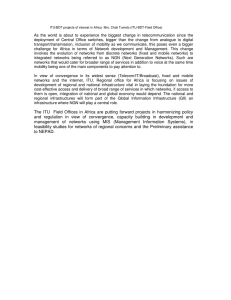Seminar Conclusions 4.2.2: Conclusions and Closing Remarks
advertisement

Seminar Conclusions 4.2.2: Conclusions and Closing Remarks ITU-BDT Regional Seminar on Fixed Mobile Convergence and New Network Architecture for the Arab Region Tunis, Tunisia, 21-24 November 2005 John Visser, P.Eng. Chairman, ITU-T SG 19 Phone: Fax: Mobile: Email: Sr. Mgr., Intl. NW Stds. +1-613-763-7028 +1-613-765-6257 +1-613-276-6096 jvisser@nortel.com Introduction • This presentation, prepared in real time to reflect the key points in about 58 presentations (approx. 1717 slides!) and discussions, aims to provide a summary of the workshop and to provide an aid to more in depth review of the material contributed. Quotations • “When you get to a fork in the road, take it!” * • “We always over-estimate the change that will occur in the next two years, and underestimate the change that will occur in the next ten years.” ** $ * Yogi Berra, American baseball player ** Bill Gates, Chairman, Microsoft Corporation “ITU-BDT Regional Seminar on Fixed Mobile Convergence and New Network Architecture”, Tunis, Tunisia - 1 1 Key Messages • “Next Generation Users” (today’s young people) are the target market for tomorrow: high expectations! • Convergence is happening: IMT-2000, IMT Advanced, NGN, BB wireless access ...: • • • • Standards efforts focussed on making vision a reality IP-based access independent core network IMS a core part of architecture Essential alignment in long term objectives of NGN and SBI2K; FMC an important aspect of both • Wireless technologies provide the means to bridge the broadband access digital divide • Strong industry alignment of visions, perspectives Let’s make it happen! “ITU-BDT Regional Seminar on Fixed Mobile Convergence and New Network Architecture”, Tunis, Tunisia - 2 Session 1.1: Opening 1.1.1 Welcome Address • Mme. Khadija Ghariani (Sec. d’ État d’Informatique, Internet et Logicielles Libres) • Warm welcome to delegates; this is first event post-WSIS II • Take advantage of “18 Nov” document: make progress • M. Ahmed Nahjoub (Prés. & Dir.-Gén., Tunisie Telecom) 1.1.2 ITU/BDT projects of interest in the Region • Miloud Ameziane (ITU/BDT Regional Office) • Welcome on behalf of ITU-BDT 1.1.3 Introductory remarks/Keynote address/ITU Structure • John Visser (ITU-T) • Seminar outline and objectives • ITU structure, sector roles “ITU-BDT Regional Seminar on Fixed Mobile Convergence and New Network Architecture”, Tunis, Tunisia - 3 2 Session 1.2: International framework 1.2.1 ITU-T Activities on NGN Architecture and Issues • Brian Moore (ITU-T SG 13 Chairman, presented by John Visser) • Establishing the FG NGN • Key Study Groups 11, 13, 19: coordinate through JCA • Involve other SGs, external SDOs • Transition into regular SGs: maintain momentum • Chae-Sub Lee (FG-NGN Chairman, presented by John Visser) • Overview of FG NGN structure, release planning, structured deliverables • Significant participation (>140), inputs (>1000) • Extensive collaboration • NGN Management Focus Group (NGNMFG) “ITU-BDT Regional Seminar on Fixed Mobile Convergence and New Network Architecture”, Tunis, Tunisia - 4 Session 1.2: International framework 1.2.2 ITU-R: Mobile convergence issues • Colin Langtry (ITU-R; presented by Kevin Hughes) • Highlighted process for identifying and allocating spectrum • IMT-2000, IMT-Advanced is being implemented and deployed, will evolve over next 10-15 years • Mobile, Internet and broadband access growing rapidly • Convergence is occurring in many spheres • New radio interfaces required around 2010-2015 • Long lead times required for spectrum planning Enhanced IMT --2000 IMT -2000 • Spectrum aspects will be considered at WRC-07 Enhancement “ITU-BDT Regional Seminar on Fixed Mobile Convergence and New Network Architecture”, Tunis, Tunisia - 5 3 Session 1.2: International framework 1.2.3 ITU-D: Regulating Convergence Convergence Policy Countries 35 30 No policy no indication 25 No policy, no plans to adopt one No policy, but planned 20 15 10 Already exists 5 0 Africa Americas Arab States AsiaPacific Europe Convergence legislation Countries 40 35 30 No 25 Planned 20 15 Already exists 10 5 0 Africa Am ericas Arab States As iaPacific Europe • Fabrizio Savi (Telecom Italia; Rapporteur ITU-D Q.10/1): • Converged regulator should ensure a level playing field • Recommend light and cost-effective regulation with limited intervention • Need forward-looking and timely regulatory framework 1.2.4 TISPAN: Telecommunications and Internet converged Services and Protocols for Advanced Networking • Alain Le Roux (France Telecom, TISPAN Chairman); presented by John Visser) • Strong industry demand for Multimedia services on xDSL • Rel. 1 target: end 2005 -> realistic, implementable solutions • Architecture based on maximizing fixed/mobile convergence through adoption of 3GPP IMS “ITU-BDT Regional Seminar on Fixed Mobile Convergence and New Network Architecture”, Tunis, Tunisia - 6 Session 1.3a: Network Evolution to NGN and Convergence 1.3.1 Shaping the Future: Mobile Network Evolution to NGN • John Visser (Nortel, Canada) • Network transformation, convergence essential to simplifying, enhancing user experience, driven by demand • Services must be “anytime, anywhere, in any form; secure, trusted, reliable” 1.3.2 3G/UMTS – An evolutionary Path to NGNs • Jean-Pierre Bienaime (Chairman UMTS Forum) • Arab Region: commercial mobile BB: EDGE & 3G/UMTS • Timely licensing: alignment w/ GSM/UMTS world to gain greater economies of scale, simplified international roaming, IPR export opportunities for services and applications, and wider choice of cost-effective terminals “ITU-BDT Regional Seminar on Fixed Mobile Convergence and New Network Architecture”, Tunis, Tunisia - 7 4 Session 1.3a: Network Evolution to NGN and Convergence 1.3.3 Mobile Network Evolution: Economic Aspects of Evolution towards IMT-2000 • Sami Tabbane (Superior School of Communications of Tunis) • Trends: convergence, new entrants, new technologies • Why evolve to 3G? New revenues, competition, user demand, ready for the future, regulatory issues • Moving to 3G is complex! 1.3.4 New Generation Networks enabling convergence of Services – Experience of Tunisie Telecom • Houerbi Rafaâ & Rim Belhassine-Cherif (Tunisie Telecom) • Services: VoIP, IP backbone, ADSL, Wi-Fi, UMTS, WLL • Technologies must co-exist, need transition period; must be demand driven; convergence is key; costs are not negligible “ITU-BDT Regional Seminar on Fixed Mobile Convergence and New Network Architecture”, Tunis, Tunisia - 8 Session 1.3a: Network Evolution to NGN and Convergence 1.3.5 Network Architecture consolidation in the evolution towards NGN • Oscar Gonzalez-Soto (Spain) • Plan business and services first, then the technology • Implement pilot cases before network migration • Competitive differentiation to competitors: services, quality Legacy Network Signaling/Service Network Independent Services Legacy Network Media 1.3.6 Mobile Network Evolution to NGN MSC TDM Network MSC RAN SGSN Packet Data Network MGW MGW Packet Network TC PSTN /PLMN Internet GGSN MSC server MSC server RAN • Roland Thies (Alcatel) • NGN: 3G UMTS R4/R5, CDMA2000 1x EV-DV • Strong architecture similarities, especially IMS/MMD • Separation of control and transport • NGN: Transport network simplification; bandwidth savings; unified new services through standardized Interfaces • New and enhanced messaging services PSTN /PLMN Internet SGSN GGSN “ITU-BDT Regional Seminar on Fixed Mobile Convergence and New Network Architecture”, Tunis, Tunisia - 9 5 Presentation brought forward due to availability constraints Session 3.1b: Operational and Regulatory Aspects of Convergence 3.1.6 Case Study: Unified Licensing Regime in India • Rajendra Singh (TRAI, India) • Convergence forcing industry realignment • Technologists can’t foresee impacts on telecom evolution • Regulators: don’t get in the way of market forces • Rural-urban teledensity gap widening: • Mobile phones most sensible, effective response to digital divide, :. must address access to a mobile network • Technology and service neutral licensing: best way to encourage competition, accommodate convergence • Partnering with poor for sustainable win-win scenarios with product and service providers • Industry supports unified licensing, industry now enjoying very rapid growth “ITU-BDT Regional Seminar on Fixed Mobile Convergence and New Network Architecture”, Tunis, Tunisia - 10 Session 1.3b: Network Evolution to NGN and Convergence 1.3.7 IP Multimedia Sub-system (IMS) and Evolution to NGN • Sami Tabbane (Superior School of Communications, Tunis) • Evolution of services and service capabilities • Evolving to strong separation of service / control / transport • Fixed-mobile convergence based on UMTS R5 IMS in NGN 1.3.8 Mobile Core Evolution towards IMS • Elena Romero (Ericsson) • IMS: common ground for datacom and telecom worlds • Standards secure interoperability and industry consensus • Trends in evolution paths: step by step evolution and migrations to using IMS as a key service enabler • “Presence” will change the way we use telecom services • Services: legacy / standardized mass market / differentiated “ITU-BDT Regional Seminar on Fixed Mobile Convergence and New Network Architecture”, Tunis, Tunisia - 11 6 Session 1.3b : Network Evolution to NGN and Convergence 1.3.9 Multiservice Packet-based Transport Network Enabling Digital Services Delivery • Mauro Filippi (Marconi) • New bandwidth hungry broadband services enable the “digital life.” How do we get there? • “Quality of Experience” a key factor in user acceptance • Keys: manageability, reliability, convergence, scalability 1.3.10 IMS, an evolutionary network architecture towards NGN • Khaled Rifai (Lucent) • IMS overlay: converged W+/W- arch. for blended services: • investment protection; product & service differentiation • multi-market segment applications and databases • Fosters and promotes the introduction of new services “ITU-BDT Regional Seminar on Fixed Mobile Convergence and New Network Architecture”, Tunis, Tunisia - 12 Session 1.3b : Network Evolution to NGN and Convergence 1.3.11 Network Modeling and PSTN-NGN Migration • Soulaimane El Bouarfati (University of Applied Sciences Frankfurt) • Describes a modeling approach to address IMS-based NGN complexity in 3 dimensions: strata, functions, planes • Significant savings in switching nodes required • Media Gateways required peak and become obsolete (ease with clever migration scenarios) 1.3.12 Signalling Protocols and Evolving Architectures for NGN • Riccardo Passerini (ITU-BDT) • Kamel Hjaiej (SUP’COM, Tunisia) • On CD-ROM, not presented “ITU-BDT Regional Seminar on Fixed Mobile Convergence and New Network Architecture”, Tunis, Tunisia - 13 7 Session 2.1a: Broadband Technologies and Solutions 2.1.1 BWA: Standards, Regulatory and Spectrum issues • John Visser (Nortel, Canada) • Telecom landscape is and continues to evolve rapidly • Telecom & ICT policy is critical to a nation’s future • Spectrum for mobility integral: get involved! 2.1.2 ITU Development activities on Wireless Communications Number of mobile subscribers 2 500 000 Sept 2000 2 000 000 2004 1 500 000 2003 1 000 000 2002 Sept 99 2001 500 000 1998 2000 0 Actual 1996 forecasts 1999 forecasts • Riccardo Passerini (ITU-BDT) • Digital Divide is narrowing but still a long way to go • Broadband access in developing countries still expensive and deployment economics are difficult “ITU-BDT Regional Seminar on Fixed Mobile Convergence and New Network Architecture”, Tunis, Tunisia - 14 Session 2.1a: Broadband Technologies and Solutions 2.1.3a Bridging the Communications Divide through WiMAX and WiMESH Solutions • Bilel Jamoussi (Nortel) • Enabler: economic growth (knowledge economy), R&D (access to knowledge), energy savings (teleworking) • WiMAX is the next phase in BB technology 2.1.3b WiMAX Update from Beijing, China Meeting Nov 7-11, 2005 • Bilel Jamoussi (WiMAX Forum) • WiMAX delivers on its promise: certified products 4Q05 • Market acceptance: >350 members, with >150 operators trialing and deploying WiMAX • 16e Mobile WiMAX profile 4Q05: Nov 05 Korea WiBRO launch, will use Mobile WiMAX Certified Product in ‘06 “ITU-BDT Regional Seminar on Fixed Mobile Convergence and New Network Architecture”, Tunis, Tunisia - 15 8 Session 2.1a: Broadband Technologies and Solutions 2.1.4 Wireless Access: the Convergence Digital Bridge - a Regional Perspective • Ibrahim Kadi (CITC, Saudi Arabia) • Arab Region, Africa lagging: paying more for less • Developed countries need to move to NGN, but need to consider legacy investment; mature population • Developing countries need to move to NGN but can do so at much lower cost: “leapfrogging” • Debate: is BB a developed country luxury? Focus instead on basic services? Leapfrog to BB may not make sense! • Can take advantage of FMC; W- BB is a better solution than deploying costly legacy style wired infrastructure “ITU-BDT Regional Seminar on Fixed Mobile Convergence and New Network Architecture”, Tunis, Tunisia - 16 Session 2.1b: Broadband Technologies and Solutions 2.1.5 Global BWA studies in ITU-R • Kevin Hughes (ITU-BR) • Details of ITU-R structure for fixed, mobile, satellite • Noted harmonization of global and regional BWA standards, considering IMT-2000 and satellite • Example to illustrate complexity of sharing studies 2.1.6 Application of Wi-Fi in supplementing Fixed, GSM and CDMA networks in the last mile • Jared Baraza (Telkom Kenya) • Wi-Fi useful transition 2G to 3G: offers fixed and mobile operators a cheap solution to roll out 3G networks • Provides cost effective (~US$1K) means to provide rural, sub-urban connectivity for communities, schools, health care, research and scientific applications “ITU-BDT Regional Seminar on Fixed Mobile Convergence and New Network Architecture”, Tunis, Tunisia - 17 9 Session 2.1b: Broadband Technologies and Solutions 2.1.7 Mobile Broadband in Rural and Remote Areas • Hamdi Breik (Lucent) • CDMA2000 1x: mature, stable, proven technology • Offers W- BB services with capacity, coverage, quality needed for urban and rural applications; compatible with future evolution; usable on many frequency bands 2.1.8 WiMAX: Application Scenarios, first experiences and evolution • Michele Morganti (Siemens) • WiMAX is important in developed countries as well as developing countries • Fits: WLAN (Hot-Spot) feed; SDSL alternative (urban, suburban); xDSL (rural) alternative; direct broadband wireless access depending on geography, population density, etc. “ITU-BDT Regional Seminar on Fixed Mobile Convergence and New Network Architecture”, Tunis, Tunisia - 18 Session 2.1b: Broadband Technologies and Solutions 2.1.9 IMT-2000 Regulatory and Spectrum Issues for Broadband Application ? • George Mansho (CFMA Development Group) • Small % change in telephony, internet usage stimulates substantial increases in GDP • Data is never fast enough nor cheap enough • Internet brings access to the world’s libraries • “When you come to a fork in the road, take it.” *i.e., keep going, you’ll get there! • Future is internet and telephony: accelerate growth • Regulators encourage to be flexible and supportive * After Yogi Berra “ITU-BDT Regional Seminar on Fixed Mobile Convergence and New Network Architecture”, Tunis, Tunisia - 19 10 Session 2.2a: Network Evolution to NGN - NGN Network Planning 2.2.2 Modeling Issues in Integrating Services in NGNs 2.2.4 Service Level Agreement (SLA) and Global QoS index for 3G networks • Villy Iverson (Technical University of Denmark; , ViceChairman, ITC) • Starting with the Erlang B formula, look at considerations in QoS: guaranteed through resource reservation; blocking probability, priority mechanisms, widely varying traffic characteristics and how they might be mixed • Analysis vs. simulation: pros & cons • What an SLA is; SLA framework & criteria “ITU-BDT Regional Seminar on Fixed Mobile Convergence and New Network Architecture”, Tunis, Tunisia - 20 Session 2.2a: Network Evolution to NGN - NGN Network Planning 2.2.1 Decision Making Requirement in Network evolution, Strategic Planning and Solution Mapping 2.2.3 Convergence Strategy for a Universal Operator and role of Business Planning • Oscar Gonzalez-Soto (Spain) • Key requirements in network planning • Modeling of multi-service flows • End-to-end performance with interconnection • Must customize to scenario: one size does not fit all • High quality tools needed for complex networks • Best solution applies appropriate technology in each area • Many potential areas of convergence: service, network, radio access, operational, terminal; economies of scale key • Maintain business indicators within margins in competition • All services, multiple customers approach: maximum returns “ITU-BDT Regional Seminar on Fixed Mobile Convergence and New Network Architecture”, Tunis, Tunisia - 21 11 Presentation brought forward due to availability constraints Session 2.2a: Network Evolution to NGN - NGN Network Planning 4.1.3 Migration to IMT-2000 in Developing Countries: The view of Policy Makers and Regulators and Market Reaction Fixed Cellular WLL(M) Lowering of ADC from 30% to 10% of sector revenue Mobile Subscriber base NTP ' 99 60 54 Effective cha rge (in Rs. per min.) CPP introduced Telecom Tariff Order 52.17 48.00 3rd & 4th cellular operator 8.00 WLL introduced 48 42 36 33.60 30 24 6.00 18 4.00 12 2.00 0.88 6.50 3.58 1.88 1.20 6 0.00 Mar-98 Mobile subscriber base (in Million) Cellular Mobile Growth and effective charge per minute 16.00 14.00 12.00 10.00 • Rajendra Singh (TRAI, India) • Drivers for IMT-2000 reviewed • Spectrum utilization efficiency, licensing process important • Spectrum allocations iun India closely match ITU allocations 0 Mar-99 Mar-00 Mar-01 Mar-02 Mar-03 Mar-04 Dec-04 Mar-05 “ITU-BDT Regional Seminar on Fixed Mobile Convergence and New Network Architecture”, Tunis, Tunisia - 22 Session 2.2b: Network Evolution to NGN - NGN Network Planning 2.2.5 Planning of Broadband Wireless Access for Rural and Remote Areas C o sts O p t im u m • Ignat Stanev (Technical University, Sofia, Bulgaria) • Service/market forecasting, access network optimization • Additional analysis to optimize for terrain coverage • Apply appropriate planning tools • Muscat-Oman case study T otal E xchanges C i r c u i ts S u b s c r ib e r s n o . o f ex c h a n g e s 2.2.6 Planning of New Generation Wireless Networks: Challenges and Solutions • Roland Goetz (LS Telcom) • Provided description of scenarios for a case study and the results achieved, illustrating aspects that need to be considered in developing an appropriate business an d technical plan “ITU-BDT Regional Seminar on Fixed Mobile Convergence and New Network Architecture”, Tunis, Tunisia - 23 12 Session 2.2b: Network Evolution to NGN - NGN Network Planning 2.2.7 Analysys STEM Case Study: Migrating Voice and Data services to an NGN platform • Robin Bailey (Analysys) • Convergence is inevitable. Best way = f(starting point) • Reduce scale of problem by analyzing a select subset • Migration process: deploy IP, migrate customers, remove old - gets worse before it gets better • Scenarios modeled: proactive, as-required, no migration: 2.2.8 VPI case study: Planning of different Broadband solutions in last mile for Urban and Suburban areas • Ignat Stanev (Technical University, Sofia, Bulgaria) • Described scenario and showed results from applying tools “ITU-BDT Regional Seminar on Fixed Mobile Convergence and New Network Architecture”, Tunis, Tunisia - 24 Session 3.1a: Operational and Regulatory Aspects of Convergence PERIOD Total Fix ed LineSubs cribers Tot al Mobile Subscribers Jun-04 Dec. 04 F eb.20 04 Jun-01 Jun-03 Jun-02 Dec-03 Jun-99 3,750,000 3,500,000 3,250,000 3,000,000 2,750,000 2,500,000 2,250,000 2,000,000 1,750,000 1,500,000 1,250,000 1,000,000 750,000 500,000 250,000 0 Jun-00 SUBSCRIBERS 3.1.1 VPI case study: Planning of different Broadband solutions in last mile for Urban and Suburban areas • Mwende Njiraini (CCK, Kenya) • Rapid growth of mobile: hard for regulators to keep pace; need to be proactive, responsive, do just what is necessary • Convergence is an opportunity: understand it, leverage it • Regulators need to be proactive, responsive, flexible • Q&A: competition in fixed segment: handle carefully! 3.1.3 Spectrum Regulation at the Age of Convergence • Lamia Delenda (France Telecom) • Challenges: are new services fish or fowl? (Is mobile TV on cell phone broadcast? Is nomadic WiMAX fixed or mobile?) • Rules should aim for equitable access, fair competition, investment to foster growth and economic advantage, avoid risk from precarious businesses “ITU-BDT Regional Seminar on Fixed Mobile Convergence and New Network Architecture”, Tunis, Tunisia - 25 13 Session 3.1a: Operational and Regulatory Aspects of Convergence 3.1.4 Current public Wireless Spectrum Regulation Issues Cost & Prices compound cost of service delivery effects of competition „Monopoly“ effects of volume / scale Market Fragmentation • Margit Brandl (Siemens) • No global database on national allocation, use of spectrum • Dichotomy: spectrum harmonization has benefits (economies of scale, roaming) but technology innovation requires flexibility (risks fragmentation) • Electronic spectrum information services are necessary if industry has to adopt to modern regulatory rules • Harmonized standards and spectrum are the way forward • Q&A: some differences in perspective on “technology neutrality” „Multiple vendors“ “ITU-BDT Regional Seminar on Fixed Mobile Convergence and New Network Architecture”, Tunis, Tunisia - 26 Session 3.1b: Operational and Regulatory Aspects of Convergence 3.1.5 The new Code for electronic communications: a technologically neutral solution • Fabrizio Savi (Telecom Italia) • Key words wrt new Italian Code: objective, transparent, nondiscriminatory, proportional, efficient (spectrum usage), timely, simple, interoperable, freedom in use, flexible regulation for interconnection 3.1.2 Licensing Aspects for IMT-2000 Licensing Approaches • Riccardo Passerini (ITU-BDT) • Statistics, competition stimulates growth; licensing approaches with pros & cons, considerations, etc. • “Beauty contest” approach preferable to auctions • Case study, consideration, results: opportunity to learn from others’ experience; focus on long term “ITU-BDT Regional Seminar on Fixed Mobile Convergence and New Network Architecture”, Tunis, Tunisia - 27 14 Session 3.1b: Operational and Regulatory Aspects of Convergence 3.1.7 Convergence in new generations of licenses: Experience of Morocco • Gihane Belhoussain (ANRT, Morocco) • Role of regulator, forces affecting regulatory directions • Review of telecoms situation in Morocco: operators, uptake • Principles: technology neutral, convergence, freedom in infrastructure selection; measured and realistic approach • Timetable for evolution of licenses: end 2005, potential 3rd licensee in 2007 “ITU-BDT Regional Seminar on Fixed Mobile Convergence and New Network Architecture”, Tunis, Tunisia - 28 Session 3.2a: Fixed Mobile Convergence 3.2.1 Trend for Fixed and Mobile users growth based on Statistics data for ICT Indicators • Ignat Stanev (ITC) • Mobile growth >>fixed; fixed not declining yet; traffic higher on fixed: lots of potential, especially in developing countries • Traditional voice expected to dominate with low IT density • Voice expected to dominate in developing countries 3.2.2 Mobile 2G/3G networks: a Universal Communication and Service solution • Roland Thies (Alcatel) • End user and operator frustrations! • Drivers: user expectations, operator needs; standards • Obstacles: regulation, NW-centric views, commoditization • 2.5G local loop/WiMAX: rapid deployment, low cost, data “ITU-BDT Regional Seminar on Fixed Mobile Convergence and New Network Architecture”, Tunis, Tunisia - 29 15 Session 3.2a: Fixed Mobile Convergence 3.2.3 IP based architectures for Wireless networks in countries with Low Fixed Line penetration • Luigi Gasparollo (Qualcomm) • CDMA provides a WLL solution • Evolve from W+ IP --> W- IP Core --> RAN IP • EV-DO road map offers near-DSL service “ITU-BDT Regional Seminar on Fixed Mobile Convergence and New Network Architecture”, Tunis, Tunisia - 30 Session 3.2b: Fixed Mobile Convergence 3.2.5 Towards Fixed and Mobile Convergence • Dan Chen (ZTE) • Carriers focus on services and applications • Hard to find killer applications so build a “killer service platform: IMS; Softswitch and IMS are closely related. • Fixed carriers more aggressive on FMC than mobile • Different carriers may have different FMC scenarios “ITU-BDT Regional Seminar on Fixed Mobile Convergence and New Network Architecture”, Tunis, Tunisia - 31 16 Session 3.2b: Fixed Mobile Convergence 3.2.7 WiMAX Solutions - Integral Elements of Fixed Mobile Convergence Networks • Hendrik Prins (Cemdia-Asia Ltd.) • WiMAX can bridge the broadband access digital divide • Quoted Nokia: “WiMAX will do for the Internet what GSM did for voice” • IMT-2000+: important in delivering high speed access • Will deliver low cost W+ speed and wide scale BB access • Critical to examine regulatory hurdles • WiMAX can deliver IMT-Advanced “ITU-BDT Regional Seminar on Fixed Mobile Convergence and New Network Architecture”, Tunis, Tunisia - 32 Session 3.3: Convergence in the Information Communication Technology 3.3.2 Bridging the Gap: taking Tomorrow’s Network into Today • Maria Cristina Bueti (ITU/SPU) • Ubiquitous Networks: anytime/where/thing/one • NGNs: packet-based, service-related functions independent underlying BB transport • Italy conducting trials: tomorrow’s network today • Italy, a developed country, but digital divide in some areas: trials addressing how to bridge “ITU-BDT Regional Seminar on Fixed Mobile Convergence and New Network Architecture”, Tunis, Tunisia - 33 17 Session 3.3: Convergence in the Information Communication Technology 3.3.3 Meeting UNICT Open Telecommunication Access Goals Using SWANsat • William P. Welty (SWANsat Project) • SWANSat: set of geosynchronous satellites to provide global BB solution for developing countries, esp. remote underserved nations • Distinctive aspect: shareware model for pricing (non-profit!) “ITU-BDT Regional Seminar on Fixed Mobile Convergence and New Network Architecture”, Tunis, Tunisia - 34 Session 3.3: Convergence in the Information Communication Technology 3.3.4 ICT Developments: Technological, Architectural, Traffic Engineering and QoS Challenges • Paul J. Kuehn (Chairman ITC) • Paradigms changing: heterogeneous technologies, services Universität Stuttgart • Success: time to market, openness, user acceptance • Design processes: specialization and automation • Standardization: open platforms, standards, quality • Research: integration of network technologies, middleware • New service paradigms: location, context-based; nomadic communications, ubiquitous computing • New business models: micropayment, QoS, security “ITU-BDT Regional Seminar on Fixed Mobile Convergence and New Network Architecture”, Tunis, Tunisia - 35 18 Session 4.1a: 2G to 3G Migration / Evolution 4.1.1 Guidelines on smooth transition from existing mobile networks to IMT-2000 for Developing Countries System A IMT-2000 Family System B System C • Nataša Gospi (Rapporteur ITU-D Q.18/2): • Developing countries entering global e-economy markets • Telecom traditionally technology and supply driven, becoming end user and market • IMT-2000 is technologically and commercially ready • Mobile BB access enables personalized service portability across network boundaries and between terminals • Transition policy to IMT-2000 must be based on analysis of key aspects impacting demand, investment and revenues “ITU-BDT Regional Seminar on Fixed Mobile Convergence and New Network Architecture”, Tunis, Tunisia - 36 Session 4.1a: 2G to 3G Migration / Evolution 4.1.2 Deployment steps for a successful UMTS launch: Example of Orange France Network • Rémi Thomas (Orange) • Description of key aspects of UMTS: same network, coverage, roaming; new radio with enhanced capabilities • Migration to UMTS: co-existence with GSM, site re-use • Enables new and innovative features • Next steps: HSDPA, HSUPA, all-IP architecture • Spectrum opportunity in “digital dividend” bands (~500MHz) for global harmonization for lower density population areas “ITU-BDT Regional Seminar on Fixed Mobile Convergence and New Network Architecture”, Tunis, Tunisia - 37 19 Session 4.1b: 2G to 3G Migration / Evolution 4.1.5 Challenges facing operators in the transition from 2G to 3G in Africa • Jared Baraza (Telkom Kenya) • Challenges: ICT priority; regulator not independent; frequency hoarding & misuse; costs; tariffs; skills shortage • Solutions: ICT to a tool for development; independent regulation; rationalized frequency allocations & licensing; transparency; broader viewpoints: local --> regional 4.1.6 From 0G to 3G in four easy steps • Helga Waage (Hex Software) • Value added services over voice network, more services via SMS, add value via MMS, enable users to easily create & share local content. Operators, techies: poor content providers high end Data hooks • Grow with lowMobile andConvergence “ITU-BDT Regional Seminar on Fixed andservices. New Network Architecture”, Tunis, customers. Tunisia - 38 Additional resource material • Appendix provides some additional references of interest: • Material on ITU web site • Material on non-ITU web sites* * N.B.: These are provided for convenience only. For non-ITU references, being listed here does NOT indicate ITU endorsement. “ITU-BDT Regional Seminar on Fixed Mobile Convergence and New Network Architecture”, Tunis, Tunisia - 39 20 Appendix: Some Additional Resources (1/3) • For supporting Developing Countries, SG 19’s action plan includes: • Implementation of ITU-T Recommendations 1.How to use ITU-T Recs., what are their relationships 2.Support BDT: applying ITU-T Recs. (Annex to Res. 44) Action: create a SG 19 discussion forum where DC-CET representatives can submit their questions: • http://forum.itu.int/jive/index.jspa?categoryID=157 • • ITU-SPU reports • 2002 Report: “Internet for a Mobile Generation” • www.itu.int/osg/spu/publications/sales/mobileinternet 2004 Report: “The Portable internet” • http://www.itu.int/osg/spu/publications/portableinternet/ • “ITU-BDT Regional Seminar on Fixed Mobile Convergence and New Network Architecture”, Tunis, Tunisia - 40 Appendix: Some Additional Resources * (2/3) • Nortel’s “Essentials of Real Time Networking”: http://www130.nortelnetworks.com/cgibin/eserv/cs/main.jsp?BV_SessionID=@@@@044962930 9.1115789159@@@@&BV_EngineID=gadddhfhejghbhkc ginchgcgjg.0&cscat=DOCDETAIL&DocumentOID=292677 &searched="real%20time%20networking • Shosteck free white papers: www.shosteck.com • 1 of several: “Lessons From Metricom and MobileStar: Success Factors for the Portable Internet Access Market” * N.B.: These are provided for convenience only. For non-ITU references, being listed here does NOT indicate ITU endorsement. “ITU-BDT Regional Seminar on Fixed Mobile Convergence and New Network Architecture”, Tunis, Tunisia - 41 21 Appendix: Some Additional Resources * (3/3) Some web sites with resource material for Regulators: ITU: www.itu.int European Commission: www.europa.eu.int Australia: www.aca.gov.au Bahrain: www.tra.org.bh Brazil: www.anatel.gov.br Equador: www.conatel.gov.ec Guernsey: www.regutil.gg India: www.trai.gov.in Ireland: www.comreg.ie Jordan: www.trc.gov.jo Kenya: www.cck.go.ke Lesotho: www.lta.org.ls Macau: www.gdtti.gov.mo Malaysia: www.mcmc.gov.my Macau: Malaysia: www.gdtti.gov.mo www.mcmc.gov.my Singapore: www.enteregulador.go b.pa www.ida.gov.sg Mauritius: Nicaragua: Nigeria: Panama: www.icta.mu www.telcor.gob.ni www.ncc.gov.ng * N.B.: These are provided for convenience only. For non-ITU references, being listed here does NOT indicate ITU endorsement. “ITU-BDT Regional Seminar on Fixed Mobile Convergence and New Network Architecture”, Tunis, Tunisia - 42 Thank you! “ITU-BDT Regional Seminar on Fixed Mobile Convergence and New Network Architecture”, Tunis, Tunisia - 43 22




